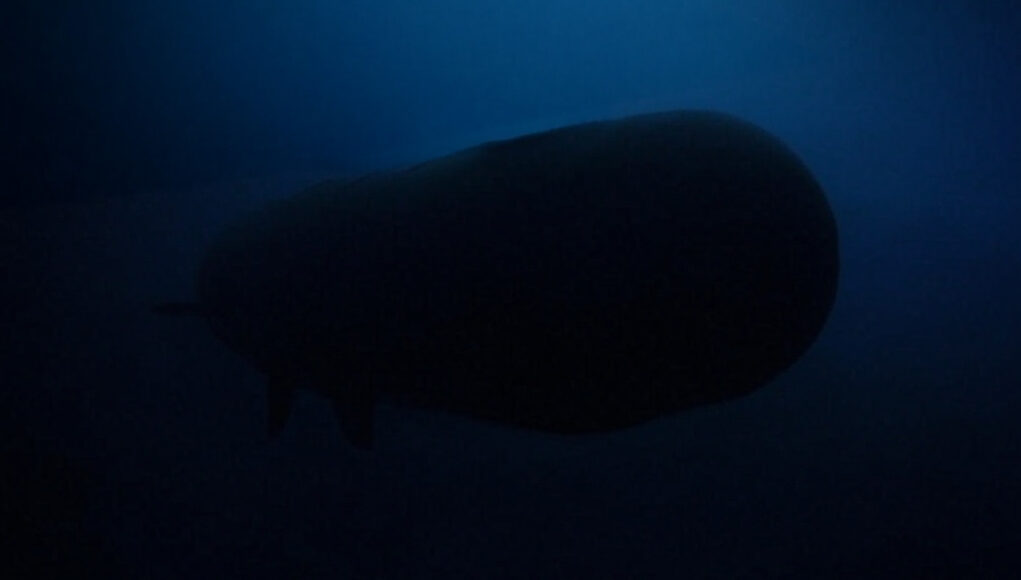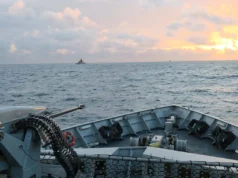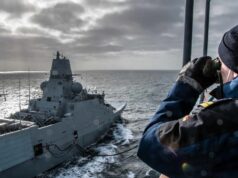For over a century, the ocean has been the ultimate refuge for those who wished to disappear.
From the U-boats of the first world war to the nuclear-powered leviathans that glide through today’s deep waters, the submarine has thrived on one simple principle: stealth.
This article is the opinion of the author David Stupples, City St George’s, University of London and not necessarily that of the UK Defence Journal. If you would like to submit your own article on this topic or any other, please see our submission guidelines.
Sound waves travel further and faster in water than light or radar waves.
This means sound is the most effective way to detect underwater objects. Modern anti-submarine warfare (ASW) is an ongoing cat-and-and-mouse game of detecting, tracking and deterring enemy submarines. With sound as the ocean’s only reliable language, ASW has primarily been a contest of listening. But the game is changing. Advances in artificial intelligence (AI), sensor networks, and autonomous vehicles are eroding the acoustic monopoly that submarines once enjoyed.
A new generation of tireless, networked and increasingly intelligent machines is beginning to patrol the seas. This promises a future where even the quietest submarine will find it harder to remain unseen. As the ocean’s soundscape becomes more crowded, navies are increasingly turning to non-acoustic methods. These technologies detect the effects of a submarine rather than its noise. Satellites equipped with synthetic aperture radar can detect subtle ripples and temperature gradients on the sea surface caused by subsurface movement.
Until recently, magnetometers, which can measure the minute disturbances a submarine creates in Earth’s magnetic field, were constrained by physics and sensitivity limits. The magnetic anomaly detectors used for ASW could only operate effectively at low altitude and at short range. Emerging quantum magnetometers, which make use of the strange science of quantum mechanics, promise orders-of-magnitude improvements in sensitivity. They could, in theory, detect the presence of a steel hull tens of kilometres away, especially when deployed in swarms aboard uncrewed aircraft or sea surface vessels.
A technique called distributed acoustic sensing (DAS) could turn ordinary undersea cables – primarily used for internet traffic – into vibration sensors. It works by measuring subtle changes in strain in the cables’ optical fibres. Through DAS, a single transoceanic cable could, in effect, become an enormous underwater microphone (hydrophone). In principle, this would allow a submarine crossing a major ocean basin to be detected by subtle pressure waves recorded in the fibres beneath it.
Autonomous vessels
At the heart of the revolution in ASW are uncrewed surface vehicles (USVs). These autonomous vessels range from small, solar-powered craft to large, long endurance ships capable of spending weeks or months at sea. Unlike crewed ships, USVs can be built cheaply and in large numbers. Armed with sonar, radar, magnetometers and communications links, they are the mobile nodes of an ocean-scale sensor network that can listen, learn and adapt in real time.
The US Navy’s Sea Hunter, an autonomous trimaran, has demonstrated its ability to track a diesel-electric submarine for extended periods without human intervention. In the UK, the Royal Navy’s Cetus project and its experimental uncrewed fleet at Portsmouth are exploring similar ideas. But it is the integration of AI with autonomy that reshapes the picture. A single USV, even a sophisticated one, can only observe a small patch of ocean. A swarm of hundreds, each communicating via satellite, laser, or acoustic link, can share information and act cooperatively.
AI is a game changer
AI does things that human operators and legacy systems cannot. It fuses data from multiple sources into a coherent picture. A single acoustic anomaly may mean little, but when combined with other data, it may form a high confidence detection.
AI operates continuously and without fatigue. Persistence is vital when hunting for the fleeting signature of a submarine designed to operate silently for weeks. And by learning how submarines navigate, avoid detection, and exploit environmental features, algorithms can forecast likely positions and movements. This could prompt ASW to move from being primarily reactive to predictive – a shift comparable to how meteorology evolved from observation to forecasting.
Through these capabilities, AI could move from simply assisting detection to orchestrating it. Humans are not leaving the loop, however. The role of human operator is shifting from hands-on detection to oversight, strategy, and what’s known as trust management. Trust is a key challenge: in this context, it’s about ensuring human decision makers understand what AI is doing and why it recommends certain actions. Navies are therefore investing heavily in explainable AI – systems that can account for their decisions – and robust communications systems that allow human operators to intervene when needed.
A connected ocean
By the 2030s, the world’s oceans may become as transparent to sensors as the skies became to radar in the 20th century. With help from AI, multiple transmitters and receivers – mounted on ships, aircraft and USVs – will be able to triangulate the positions of submarines in real time. Swarms of autonomous underwater vehicles – relatively small robotic drones – will patrol close to shore, relaying data to surface craft. Satellites will flag anomalies for local sensor networks to investigate. And the fibre-optic infrastructure that spans the seabed may double as a global array of undersea microphones.
For now, such a vision remains technically ambitious. The ocean is extraordinarily complex: temperature gradients, salinity layers, and seabed topography all distort signals and confound algorithms. But with every incremental improvement in AI modelling and computational power, those obstacles shrink. As detection grows more sophisticated, so too will the submarines. The future may see submarines using propulsion systems and materials in their hulls that leave minimal thermal or acoustic signature. Decoy drones could be used to confuse detection systems.
Some analysts predict that submarines will operate deeper and slower to evade wide-area surveillance. A shift towards autonomous undersea drones that can saturate defences through sheer numbers is also possible. The strategic implications are profound. Submarines have long been the cornerstone of nuclear deterrence and covert power projection. Their ability to vanish beneath the waves gave nations second-strike capability (the ability to retaliate after absorbing a nuclear attack) and freedom of manoeuvre.
The result of AI-driven transparency could be greater stability – reducing incentives for surprise attack – or, paradoxically, new instability as nations race to preserve secrecy.
The submarine will remain a formidable weapon, but it will no longer move unseen. The ocean, once humanity’s final hidden frontier, is becoming transparent to the eyes of machines.![]()
David Stupples, Professor of Electrical and Electronic Engineering and Director of Electronic Warfare Research, City St George’s, University of London. This article is republished from The Conversation under a Creative Commons license. Read the original article.














A slow moving submarine doesn’t create much of a pressure wave nor any real noise.
With the reactor shut right down there won’t be much thermal either.
Nothing new. It has been the same game of cat and mouse since the first days of ASDIC . They subs get better, the detection methods improve, the subs improve even more. Same cyclic game of cat and mouse.
Just as has happened in air warfare.
“plus ça change, plus c’est la même chose”.
I heard that the Chinese are actively digging tunnels under the USA to place atomic bombs.
It would make a great film.
Battle beneath the earth.
Very good 👌
It’s nice to see someone gets it !
Dr Strangelove had something very similar, at the end of the movie they were thinking of digging mineshafts, and starting a new arms race 🙂
AI, AI, AI . . Don’t, get me wrong, I design and develop it, makes me a tidy sum but its such a moniker for solving or undoing everything. The truth is, there is no AI in the truest sense of the word, only complex models & algorithms, lets not get too taken away with the potential promise or terror. Back on topic, if I recall, one of the terminator movies had the Jimmy Carter, undetected for over a decade by Skynet until they gave away their position 🙂
This is why the nuclear triad is so important, so that no single technology breakthrough can neutralise your entire deterrent posture.
So the UK buying F35A’s isn’t such a bad Idea then ?
No because that is not a nuclear triad, it’s carting the USAs tactical nuclear weapons around for them.. great for US deterrent.. not so much our own.
We need to cozy up to France and buy them a glass of wine and get an invite into the ASN4G programme and get those integrated into tempest.. that would be a sovereign air launched capability …
Better late than never, although I don’t know which genius reckoned that a total inventory of 12 airframes constitutes a credible force. UK orders for new kit seem to inhabit a world of extreme bare minimum quantities which don’t allow for downtime (repairs, maintenance, upgrading) never mind some reserve to take account of combat losses.
I think if the B varient could carry B61’s, It would have been the better option.
I have no idea whether UK F35Bs are nuclear coded, never seen it mentioned. Perhaps someone can enlighten us on that subject?
Whilst I might think it technmically possible to detect submarines whilst submerged I am not seeing the prostect of a detection system identifying the position of submarines worldwide as likely anytime soon. You can bandy about terms like AI all you like, but it is completely meaningless at the moment. AI does not overcome the laws of physics which are currently standing in the way. Sure we can detect lots of different shifts in energy including gravity and over long distances. Personally I suspect we will have world peace long before a workable solution to this problem arrives meaning that submarines are still the best option for stealth at this time and well into the future.
AI, the future.
AI is a misnomer. It always requires a human and human consciousness to make sense of what is highlighted; AI has no intelligence that is not human in origin. Many times in past conflicts the human miscalculation has been significant and frequently, final. The writer seemingly assumes the oceans are very quiet.
“Sound waves travel further and faster in water than light or radar waves.”
WTF? 🤦🏻♂️🤦🏻♂️
In water, sound does NOT travel faster than light.
I’d hope anyone with a basic grasp of physics knows that.
Yes I’m not quite sure but I suspect he left a few words of his sentence.l maybe it was to read “ sound travels fast in water than in air, where as light radar waves slow down in water and sound waves travel far farther in water than light or radio waves.. that’s correct… he needed more connecting words.
It could be that it was badly edited to fit a word count. Maybe if separate sentences for distance through water, and speed through water, had been used then it would have been clearer to read and not resulted in this howler.
Really undermines confidence in the author subsequently says when they make such an error in the first paragraph.
Yep it’s a bit of a sore thumb statement.. sort of like saying the sun is cold.
It should read –
Sound waves travel further in water than light or radar waves.
Lght or radar waves travel faster than sound in water, however, light loses energy through Photon absorption, hence, there isn’t any significant light beyond 200 meters.
This is exactly what Vice-Admiral Angus Topshee, commander of the RCN, warned about a couple of weeks ago. A lot of people on here found it amusing but now we have an electrical engineer specializing in electronic warfare confirming what Adm. Topshee said. Well, since the author of this article is a Brit and not a Canadian maybe readers will take it a bit more seriously this time.
AI will need to improve a lot. I used a popular one recently for s probsbility test – I had to explain to it why it got it wrong!
Like all “new” ideas? Detractors treat articles and predictions like this with scepticism. Then a few years back, the sight of an infantryman fleeing in fear from a plastic drone would have seemed like science fiction. Now it is daily reality.
I personally am glad I soldiered when I did, these predictions tend to become reality quickly nowadays. I see no reason this one will not either.
Which will affect Russian and Chinese submarines just as much, yes?
Probably more to be honest due to geography.. both china and Russia tend to have restricted access to deep oceans. It’s one of the massive strategic advantages china will get if it gets its mits on Taiwan, it will Break the straight jacket effect of the first island chain and have direct deep pacific access.. its if you get a map of china and the first and second island chains then turn it all 90 degrees you end up with a map that clearly shows why Taiwan is a linchpin.
AI is only as good as the people who have coded it, it will only recognise indicators of a sub that human operators recognise. Perhaps it may (or may not) be more accurate and faster at recognising these, that doesn’t mean subs will have nowhere to hide though. The AI can only process what data sensors supply to it, the same limitation that human operators have, the oceans are not covered with sensors that can detect the smallest annomoly absolutely everywhere.